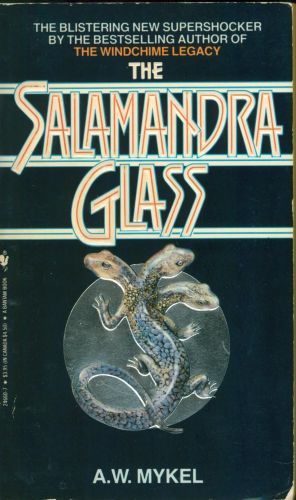

|
| 1985 edition: Cover art by Larry Lurin |
| THE SALAMANDRA GLASS A. W. Mykel New York: Bantam Books, February 1985 |
Rating: 5.0 High |
|||
| ISBN-13 978-0-553-24660-5 | ||||
| ISBN-10 0-553-24660-7 | 529pp. | SC | $3.95 | |
Christian Gladieux had been a hero of the French Resistance during World War II. Now he was an accomplished novelist living in Spring Lake, New Jersey. But for two years he has produced little, and friends find him troubled by something he will not discuss. During this period he received threatening letters, and it culminated in his mysterious, brutal murder.
Now it falls to his children to seek out the answers to the complex mystery. Fortunately, he has very formidable children — especially Michael, a commando type with long experience in the Viet Nam War. But they are dealing with an equally formidable secret organization, and a member fighting for his own survival. Victory will require all Michael's skill and courage.
"It was early morning when the train pulled into the ancient city of Arles, situated beside the Grand Rhône River on the northern edge of the Camargue. The group traveled across the Ile de la Camargue toward Saintes-Maries-de-la-Mer in St. Jude's car, which had been left in Arles. St. Jude's manade, or ranch, was five kilometers north of the capital city." "It was an enjoyable drive. The weather was perfect and the air streaming in through the open windows felt and smelled wonderful. St. Jude spoke proudly of the Camargue as they drove, artfully mixing history and legend. The Ile de la Camargue had been famous since Roman times for its marvelous fighting bulls and its wild white horses, which became symbols of the Roman legions. Roman officers rode upon the magnificent white stallions of the Camargue. Caesar's Sixth Legion fought under the emblem of the bull, inspired by the courageous, fearsome Camarguian bulls. Some Roman soldiers were even given land in the Camargue as a reward for heroism during the conquest of Marseilles in 49 B.C." – Pages 256-7 |
Commissioned by a German general in 1936, these medallions were painstakingly crafted by a master glassmaker under the utmost discretion. They were compounded of hundreds of "canes" — slender filaments of glass, each with its own distinct composition. The introduction makes it clear that these many canes, plus the fine quality of the craftsmanship, guarantee their uniqueness. Whoever carried an attempted fake could be easily detected. It's also clear they are intended for some secret organization, probably not a part of the German military.
What remains unclear is how many medallions were produced, and the nature and purpose of the secret organization whose members carry them as unduplicatible talismans of identification.
Like John D. MacDonald's One Fearful Yellow Eye, this tale revolves around sinister Germans from the World War II era. But, unlike MacDonald's tale, The Salamandra Glass introduces them right up front. Indeed, Mykel habitually telegraphs later developments to the reader.
Or rather, he does this through the first third of the book. It's more accurate to call them "hooks" which increase the reader's anticipation. Plenty of mystery is withheld until the end. Another difference is that Mykel inserts much more historical and geographical information — as in the travelogue-like passage quoted above.
The plot functions on two main levels. Uppermost is the struggle of the Gladieux family — son Michael, daughter Gabrielle Preston, and her husband Danny Preston — to uncover the identity and motive of their father's killer. Interwoven below that is the saga of Christian's exploits as French infantryman and Resistance fighter during World War II, as recounted by his surviving compatriots in France. And a gripping saga it is.
Another plot thread involves an apprentice from the master glassmaker's shop, a Jew, who is sent to a concentration camp, and the fate of his little sister with whom he treks from Dresden into Czechoslovakia to avoid persecution. Yet another is whether Michael will stay true to his avowed rejection of the group with which he was allied in Viet Nam. And that does not exhaust the list.
Mykel throws in some standard potboiler elements. There is Nicole, a headstrong French beauty, as a love interest for Michael. And he describes plenty of small arms in detail1 — as he does their effects on the human body. Considering the attention paid to weapons, it puzzles me that the use of a ground-to-air missile comes as such a complete surprise to the good guys. Also, I think the escape of the glassmaker's apprentice could have been handled better. He treks day and night along the roads for over a hundred kilometers, driving himself to the point of exhaustion (so he's not what you could call wary) and encounters absolutely no one — until he has entered Czechoslovakia and meets a friendly truck driver.
But I can discount those points and the errors mention on my Errata page. This is a well-crafted mystery, worthy of top marks.

 To contact Chris Winter, send email to this address.
To contact Chris Winter, send email to this address.